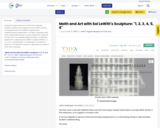
Powers of Ten Algebra Readiness Remediation Plan
- Subject:
- Mathematics
- Material Type:
- Lesson Plan
- Provider:
- VDOE
- Author:
- VDOE
- Date Added:
- 10/07/2024

Powers of Ten Algebra Readiness Remediation Plan

Exponents and Perfect Squares Algebra Readiness Formative Assessment

Whole Number Exponents and Perfect Squares Mathematics Instructional Plan

Just in Time Quick Check Exponents and Perfect Squares

Using the Virginia Museum of Fine Arts website, students explore the sculptural work of 20th Century Conceptual artist Sol LeWitt to expand their understanding of geometric concepts, creatively play with mathematical ideas, and be inspired to make art of their own.
The website page provides a scaffolded approach to exploring Sol LeWitt's sculpture titled "1, 2, 3, 4, 5, 6." culminating in a challenge for students to build a 3-D Tinkercad model of a geometry concept of their own choosing.

Passwords are essential to protecting our private information from others. Use this lesson to explore some basic probabilty behind password options and how easily they can be guessed! This lesson provides an intro into cybersecurity and its vocabulary, as well as incorporates low prep activities you can modifiy to fit your needs.

This video is part of the Continue to Know with WHRO TV series. Watch Ashley Ehret teach about exponents.

This video is part of the Continue to Know with WHRO TV series. Watch Ashley Ehret teach about perfect squares.

Investigating positive exponents and perfect squares Mathematics Instructional Plans (MIPs) help teachers align instruction with the Mathematics Standards of Learning (SOL) by providing examples of how the knowledge, skills and processes found in the SOL and curriculum framework can be presented to students in the classroom.